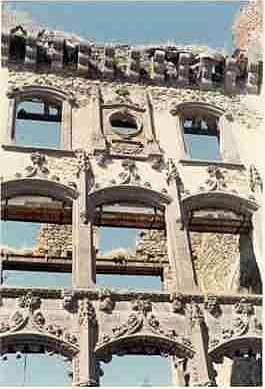
The Vercors Massif is a range in France consisting of rugged plateaus and mountains straddling the départements of Isère and Drôme in the French Prealps. It lies west of the Dauphiné Alps, from which it is separated by the rivers Drac and Isère. The cliffs at the massif's eastern limit face the city of Grenoble.

The French Alps are the portions of the Alps mountain range that stand within France, located in the Auvergne-Rhône-Alpes and Provence-Alpes-Côte d'Azur regions. While some of the ranges of the French Alps are entirely in France, others, such as the Mont Blanc massif, are shared with Switzerland and Italy.
The 2000–2006 municipal reorganization in Quebec resulted in large-scale amalgamation of smaller municipalities in Quebec into larger cities. It was undertaken by one administration, and modified and partially undone by its successor.
L'Étape du Tour de France is an organised mass participation cyclosportive that allows amateur cyclists to race over the same route as a Tour de France stage. First held in 1993, and now organised by the Amaury Sport Organisation (ASO), it takes place each July, normally on a Tour rest day.
Col de la Croix is the name of the following passes:
The RCW Catalogue is an astronomical catalogue of Hα-emission regions in the southern Milky Way, described in. It contains 182 objects, including many of the earlier Gum catalogue objects.

Ayrens is a commune in the Cantal department in the Auvergne-Rhône-Alpes region of south-central France.

La Fare-en-Champsaur is a commune in the department of Hautes-Alpes in the Provence-Alpes-Côte d'Azur region in southeastern France.

Saint-Aubert is a municipality in Quebec, situated in the L'Islet Regional County Municipality and the Chaudière-Appalaches administrative region. Saint-Aubert lies in the Côte-du-Sud federal electoral district.

The Fortified Sector of the Dauphiné was the French military organization that in 1940 controlled the section of the Alpine Line portion of the Maginot Line facing Italy in the vicinity of Briançon. By comparison with the integrated defenses of the main Maginot Line, or even of the Fortified Sector of the Maritime Alps to the south, the Dauphiné sector consisted of a series of distinct territories that covered two main invasion routes into France: the route from Turin over the Col de Montgenèvre to Briançon and Grenoble, and the route from Coni over the Col de Larche to Barcelonette and Gap. The sector was the scene of probing attacks by Italian forces during the Italian invasion of France in 1940, in which the French defenses successfully resisted Italian advances until the June 1940 armistice that granted Italy access to southeastern France.
The 2004 Quebec municipal referendums were held by the Quebec Liberal Party government of Jean Charest that came to power in the 2003 Quebec election, in fulfillment of a campaign promise to allow voters to have a say regarding the municipal reorganization program that had been undertaken by the preceding Parti Québécois administration.
The 2013 Tour de France King of the Mountains is Nairo Quintana. He won the mountains classification of the 2013 Tour de France which is in place to decide the best climber of the tour. The race featured 5 Hors catégorie climbs, 6 Category-one climbs, 12 Category-two climbs, 16 Category-three climbs, and 17 Category-four climbs. That means the 2013 Tour de France included 28 mountain climbs or altitude finishes ranked Category-two, Category-one or Hors catégorie compared to 25 in 2012, 23 in 2011 and 25 in 2010. 4 of these climbs are in Corsica, 2 in the Massif Central, 7 in the Pyrenees and 15 in the Alps. Notable climbs in this year's tour include Col de Pailheres, Col de la Madeleine, Annecy-Semnoz, Mont Ventoux and Alpe d'Huez (twice).